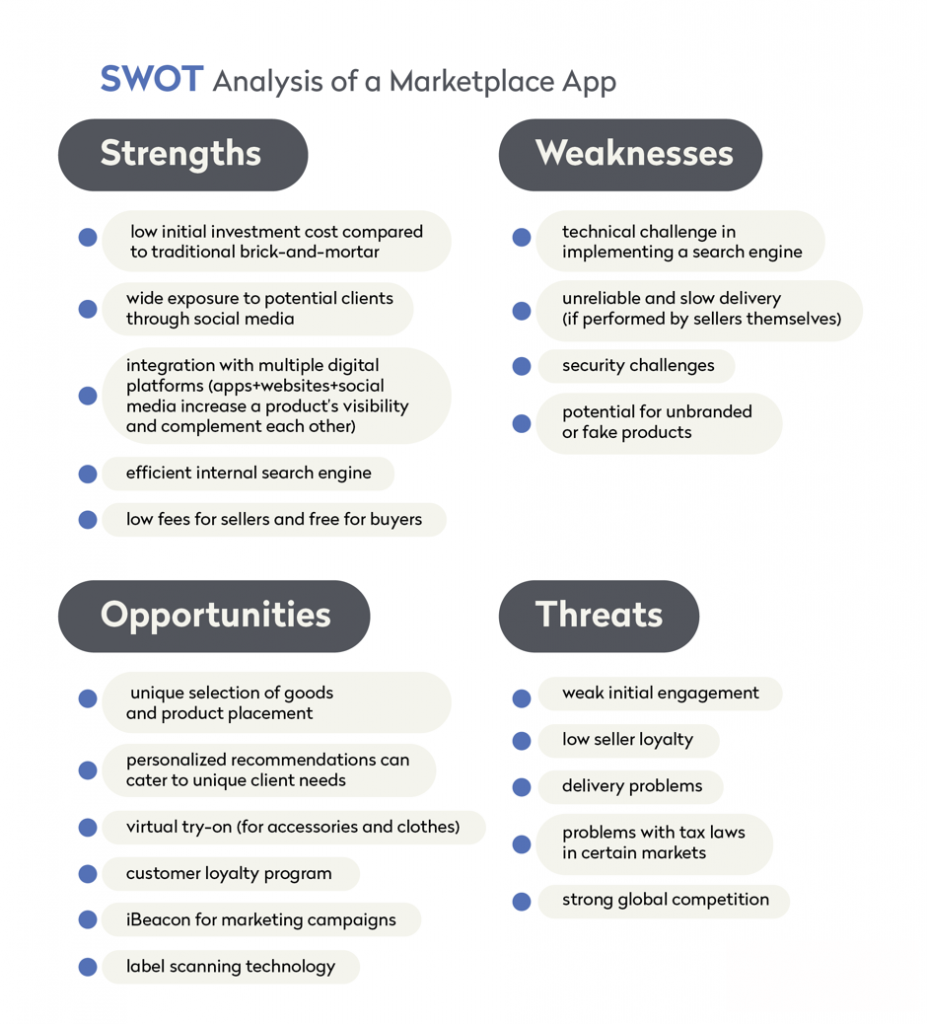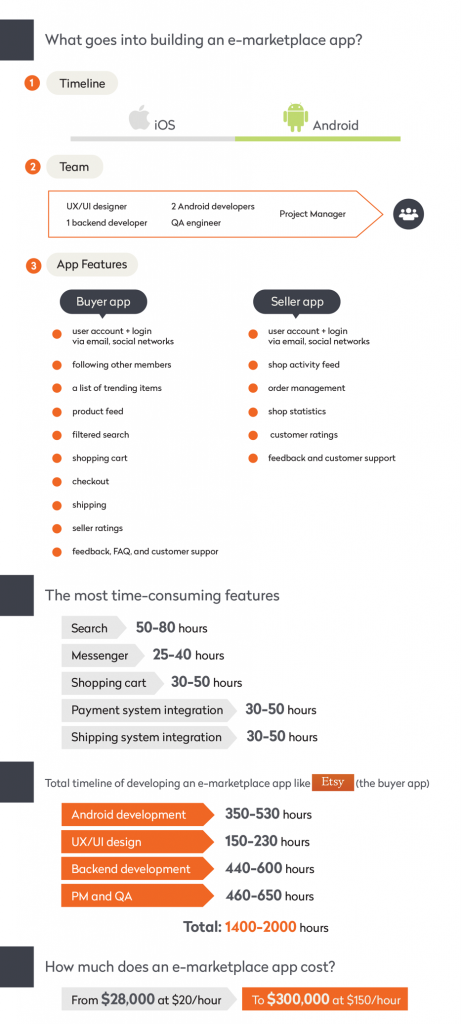Let’s imagine you decided to develop an app, where you coordinate the relationship between sellers and buyers.
How much does it cost to create a mobile or web application like eBay or Amazon? Shopping app development costs depend on the product’s features. So, to answer your question we should start with the SWOT analysis.

Analyse the market
Analysis of competitors can be focused on a particular country, a particular continent, or be focused on the global competition. There is not much point in focusing your app strategy on trying to compete directly with e-commerce giants. It is generally better to develop an app with several key functions and a simple but attractive user interface and then test it out to see how it works for your business.
Using our SWOT you can come up with a list of features that will make your app successful and profitable. In example we tried to concentrate on major factors that can predict an app’s success or failure.
Define your product
There are four most effective types of customer benefits: the best quality, the best quality-to-price ratio, luxury and aspiration, and “must-have.” To understand and evaluate your value proposition, you need to answer the following questions:
- What product or service is your company selling?
- What is the end-benefit of using it?
- Who is your target customer for this product or service?
- What makes your offering unique and different?
On the online commerce landscape it’s hard to make a difference, because all major product features are pretty much the same between your and your competitors’ app. But you can always win by offering small value-adds or something that could be attractive to some buyers. This can be free shipping, next day shipping, free bonus with a purchase, money-back guarantee, a discounted price, customization, free product listing for sellers, and other small add-ons.

Create a list of features that increase app performance
Before you settle on a particular type of app you need to work on establishing your priorities and determining what you expect from the app. This is when you have to consider key performance indicators. Choosing which indicator is a priority for your project will define design and major features of your marketplace app.
One of the most important indicators for apps is lifetime value. Other significant indicators include retention rate and number of active users, session length and average revenue.
- Retention rate – how many clients come back to use your app again and again
- User engagement metrics:
- session length – how much time does a user spend in your app?
- number of active users – how many people use your app at a given period of time
- conversion – the percentage of visits that result in goal conversions or e-commerce transactions.
We can list at least three features that increase user engagement with a shopping app:
A/ Style Boards. Creating looks and expressing styles with style boards and collections is fun and engaging. Style boards can potentially lead users to purchasing decisions. The Polyvore app, for example, offers users an opportunity to create beautiful collages of fashion items they find in the app and share their creations with the fashion community. While searching for fashion items to complete their style boards, users can come across several items they will actually want to buy.
B/ Trendsetter badges. You can reward your users with badges based on their engagement. A badge can be achieved when a user collects a certain number of points by gaining followers, inviting friends, liking products, and buying goods. For some users, a desire to become a trendsetter can be so tempting that they might even want to buy some points to get the trendsetter badge in the app.
C/ Virtual try on. By letting users create an avatar with their body type to try on different clothing items from fashion retailers you can dramatically increase user engagement.

- Revenue – how much money does your app make
Transaction fee revenue is the most profitable revenue model for e-commerce apps that function as intermediary marketplaces. This revenue model comes in a basic and a more complicated form. The revenue is based on the volume of transactions made. More complicated models can include several different fees:
- Insertion fee – when a new item is listed on the app, there is a small non-refundable fee that is charged.
- Promotional fees – certain items are listed higher on the page to attract more attention.
- Commission – a fee that the seller has to pay at the end of the auction.
The best way to increase revenue in any shopping app is by providing tangible rewards like gift cards or discounts.
Learn about the cost of app development
In our estimate we considered Android app design and development and API design and development. We only look at the cost of a buyer’s app here; usually apps for sellers are built on the existing platform of e-commerce web applications.
The cost will depend directly on the number of hours developers spend working on the app, but the hourly rates depend on a particular company.
Here are some key elements for an e-marketplace app that you should concentrate on initially:
- a simple and memorable UI with a recognizable logo,
- essential filters,
- layout,
- user-friendly and secure checkout with a shopping cart.
Once you have established which features are most desirable and profitable, then expand them.
Source: https://yalantis.com/blog/marketplace-app-development-types-kpis-features-recommendations-and-costs/

